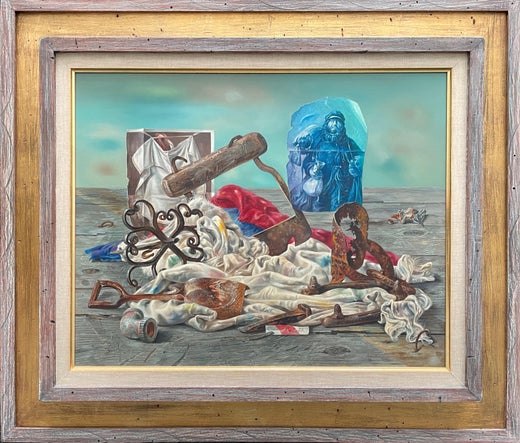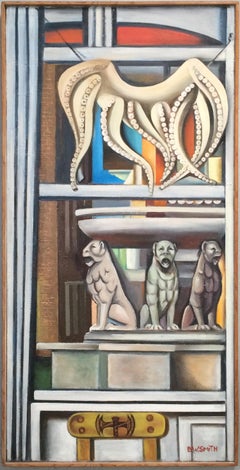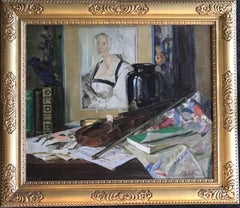Want more images or videos?
Request additional images or videos from the seller
1 of 11
Aaron BohrodTree of Life oil painting by Aaron Bohrodcirca 1955
circa 1955
$10,000List Price
About the Item
- Creator:Aaron Bohrod (1907 - 1992, American)
- Creation Year:circa 1955
- Dimensions:Height: 24.25 in (61.6 cm)Width: 12.25 in (31.12 cm)
- Medium:
- Movement & Style:
- Period:
- Condition:
- Gallery Location:Hudson, NY
- Reference Number:Seller: BoAa0051stDibs: LU2465213163032
Aaron Bohrod
Aaron Bohrod's work has not been limited to one style or medium. Initially recognized as a regionalist painter of American scenes, particularly of his native Chicago, Bohrod later devoted himself to detailed still-life paintings rendered in the trompe l'oeil style. He also worked for several years in ceramics and wrote a book on pottery. Born in 1907, Bohrod began his studies at Chicago's Crane Junior College in 1925, and two years later enrolled in the Art Institute of Chicago. But it was at the Art Students League in New York City, from 1930 to 1932, that he studied under the man believed to be his most significant early influence, John Sloan. Sloan's romantic realism is reflected in the many depictions of Chicago life, which comprised most of Bohrod's early work. Under Sloan's tutelage, Bohrod came to subscribe to the belief that painters should find the subjects of their art in the immediate world around them. These paintings emphasized architecture unique to north Chicago and featured Chicagoans engaged in such everyday activities as working, playing or going to the theatre. The romantic aspect was conveyed by the use of misty colors, and the realism by attention to detail. In 1936, Bohrod won the Guggenheim Fellowship award in creative painting. It enabled him to travel the United States, producing similar regionalist paintings on a much broader range of subjects. Nevertheless, most of his early work centered on Chicago and the urban Midwest. In 1943, Bohrod was commissioned by editors of Life magazine to cover the battlefronts as a war correspondent and artist. Three years later, Bohrod was invited to become the Artist in Residence at the University of Wisconsin, a position that became vacant with the unexpected death of John Steuart Curry. He would remain at the University from 1948 to his retirement in 1973. Then, quite atypically, fantasy started to appear in his work. Elements of Surrealism, supposedly inspired by his concurrent involvement in ceramics with F. Carlton Ball, began influencing his landscapes. By 1953, Bohrod had completely ceased painting landscapes, turning instead to often symbolic still-life subjects. He abandoned his earlier romantic realism to paint in the luminous trompe l'oeil tradition of William Harnett. Bohrod continued to produce these meticulously crafted fantasies exclusively. While in his position at the University of Wisconsin, Bohrod painted covers for Time magazine and authored two books, A Pottery Sketch-book (1959) and A Decade of Still Life (1966), in which are produced many of his trompe l'oeil paintings.
About the Seller
5.0
Vetted Professional Seller
Every seller passes strict standards for authenticity and reliability
Established in 1973
1stDibs seller since 2023
13 sales on 1stDibs
Authenticity Guarantee
In the unlikely event there’s an issue with an item’s authenticity, contact us within 1 year for a full refund. DetailsMoney-Back Guarantee
If your item is not as described, is damaged in transit, or does not arrive, contact us within 7 days for a full refund. Details24-Hour Cancellation
You have a 24-hour grace period in which to reconsider your purchase, with no questions asked.Vetted Professional Sellers
Our world-class sellers must adhere to strict standards for service and quality, maintaining the integrity of our listings.Price-Match Guarantee
If you find that a seller listed the same item for a lower price elsewhere, we’ll match it.Trusted Global Delivery
Our best-in-class carrier network provides specialized shipping options worldwide, including custom delivery.You May Also Like
1950s "The Schoolgirl" Oil and Sand Figurative Painting NYC Brooklyn Museum
By Sylvia Rutkoff
Located in Arp, TX
Sylvia Rutkoff (1919-2011)
26-1
"The Schoolgirl"
c.1950s
Oil paint, sand on Masonite
36x48 wood period frame
Unsigned
Collection acquired from family estate
Sylvia Weinreb Rutkoff (...
Category
Mid-20th Century Modern Abstract Paintings
Materials
Gesso, Masonite, Oil
$14,000
H 36 in W 48 in D 2 in
1950s "Traffic" Oil and Sand Abstract Painting NYC Brooklyn Museum
By Sylvia Rutkoff
Located in Arp, TX
Sylvia Rutkoff (1919-2011)
"Traffic"
c.1950s
Oil, sand, grout, gesso on masonite
48"x36" wood period frame
Signed on reverse in pencil
Collection acquired from family estate
Sylvia ...
Category
Mid-20th Century Modern Abstract Paintings
Materials
Gesso, Masonite, Oil
$14,000
H 36 in W 48 in D 2 in
Charles McGee Oil Painting "Squares and Things" African-American 1967
By Charles McGee
Located in Detroit, MI
"Squares and Things" painted by the eminent artist, Charles McGee, literally breaths his African American heritage and his extraordinary vibrant use of colors. Provenance is The Arwin Galleries on Grand River in Detroit, Michigan - label on verso.
This early painting of McGee's shows his mastery in creating a painting in the style of the French Impressionist Edouard Manet, "Still Life with Melon and Peaches" located in the National Gallery of Art, Washington, DC, and in the style of Fauvist/Expressionist painter Henry Matisse, "Still Life with Blue Tablecloth", located in the Hermitage Museum, Saint Petersburg, Russia. McGee makes the well-known genre of still life his own creating an exciting marvelous work incorporating the homely quilt - the powerful symbol of the African American road to safety from slavery - as his main focus. Quilts symbolize warmth, comfort, and as shown by the collection of quilts gathered by the artists in Gee's Bend the designs on the quilts hung outdoors at locations along the Underground Railroad showed fugitives the road north and to safety. "Squares and Things" was first shown at The Arwin Galleries, Inc., Detroit, Michigan, one of the stops along the Underground Railroad.
This piece is signed by the artist, Charles McGee, and is an extraordinary example of his early work before he moved into Abstract Expressionism and his many sculptural works now located throughout Michigan. Several of these works are: "Noah's Ark: Genesis, 1984," on display at the Detroit Institute of Arts, his brilliant 2005 "Progression" a 45-foot wide aluminum sculpture at Beaumont Hospital, Royal Oak, Michigan, and his stunning 2016 "United We Stand" sculpture at the Charles H. Wright Museum of African American History . His genius can be seen in sculpture installments throughout the city of Detroit. .
He was born into a family of sharecroppers. While helping his grandfather tend the land, "he observed firsthand the order and harmony that exists within nature." He had no formal schooling until moving to Detroit at age 10, where he found that "everything was on the move and it hasn’t slowed down yet." in 2017 he observed, "I learned something not being in school — because life is school . . .I learn something every time I move. Every time I go around a corner, something new is revealed to me.”
McGee took advantage of the GI Bill to attend classes at the Society of Arts and Crafts, now the College for Creative Studies, Detroit, MI. Other College for Creative Studies (formerly Center for Creative Studies) faculty and graduates include Richard Jerzy, Harry Bertoia, Doug Chaing (currently director of Lucas Film), Stephen Dinehart (game maker, writer, designer connected with The David Lynch Foundation), Tyree Guyton (international artist), Herb Babcock, Jerome Feretti, Kevin Siembieda (writer, designer and publisher of role-playing games), Renee Radell, and Philip Pearlstein.
After retiring from the Corps of Engineers, McGee spent 1968 studying art in Barcelona. Despite not knowing the language at the outset, he immersed himself in the culture and opened himself to a whole new range of experience that would play out in his artwork. "If you free yourself, you have this kind of opportunity to have those experiences, horizons, and new vistas." (per interview with Nick Sousanis author of a book on Charles McGee.)
He returned to Detroit and curated "Seven Black Artists" at the Detroit Artists Market in 1969, which along with McGee himself, included Lester Johnson, Henri Umbaji King, Robert Murray, James Lee, Allie McGhee...
Category
Late 20th Century American Modern Still-life Paintings
Materials
Masonite, Oil
$45,000
H 49 in W 37 in
Coquillage et réveil en rouge by Henri Hayden - Still Life Painting
By Henri Hayden
Located in London, GB
Coquillage et réveil en rouge by Henri Hayden (1883-1970)
Oil on paper laid down on isorel
33.5 x 46 cm (13 ¹/₄ x 18 ¹/₈ inches)
Signed and dated lower le...
Category
1960s Modern Figurative Paintings
Materials
Masonite, Oil, Laid Paper
$5,235
H 13.19 in W 18.12 in
'Still Life', Carnegie, Biltmore, Mills College, CPLH, LACMA, WPA, Hollywood
By Boris Deutsch
Located in Santa Cruz, CA
'Still Life', Carnegie, Biltmore, Mills College, CPLH, LACMA, WPA, CWS, Hollywood
Signed, lower right, 'Boris Deutsch' (Lithuanian-American, 1892-1978) and dated 1926.
Deutsch bega...
Category
1920s Modern Still-life Paintings
Materials
Canvas, Masonite, Oil
$2,850
H 16 in W 19.75 in D 1 in
Windowsill Garden
Located in Astoria, NY
Charles Blum (New York, 1925-1998), Windowsill Garden, Oil on Masonite Panel, 1966, signed and dated lower right, wood frame. Image: 48" H x 23.75" W; frame: 53" H x 29" W. Provenanc...
Category
1960s American Modern Interior Paintings
Materials
Masonite, Oil
A Fabulous 1950s Mid-Century Modern Still Life of a Colorful Bouquet of Flowers
By Francis Chapin
Located in Chicago, IL
A Fabulous, 1950s Mid-Century Modern Still Life Painting of a Colorful Bouquet of Spring Flowers by Notable Chicago Artist, Francis Chapin (Am. 1899-1965). Completed in the vibrant,...
Category
Mid-20th Century American Modern Interior Paintings
Materials
Masonite, Oil
$950
H 11.75 in W 11.25 in D 1 in
An Exceptional Mid-Century Modern Still Life Painting, Fruit and Gold Fish Bowl
Located in Chicago, IL
An Exceptional Mid-Century Modern Still Life Painting of Fruit and a Gold Fish Bowl
by Noted Chicago Artist, Rudolph T. Pen. Completed in the 1960s, this large, unique, richly rende...
Category
Mid-20th Century American Modern Still-life Paintings
Materials
Masonite, Oil
$1,800
H 25 in W 37 in D 2 in
A Large, Vibrant 1950s Mid-Century Modern Still Life Painting / Interior Scene
Located in Chicago, IL
A Large, Vibrant 1950s Mid-Century Modern Still Life Painting / Interior Scene by Noted Chicago Artist, Rudolph T. Pen. Depicts a delightful interior scene painted in subtle harmoni...
Category
Mid-20th Century American Modern Interior Paintings
Materials
Masonite, Oil
A Vibrant, Colorful 1950s Mid-Century Modern Still Life Painting by Rudolph Pen
Located in Chicago, IL
A Vibrant, Colorful 1950s Mid-Century Modern Still Life Painting by Noted Chicago Artist, Rudolph Pen. Depicting a radiant still life of fresh flowers, plates of fruit and a wine bo...
Category
1950s American Modern Still-life Paintings
Materials
Masonite, Oil
$1,600
H 17 in W 25 in D 2 in
More From This Seller
View AllReflections of Crete oil painting by Beatrice Wose Smith
Located in Hudson, NY
Original frame which measures 43" x 22" x 1.5"
Signed lower right "B. W. Smith"
Signed, titled and listing original price verso in pencil on label 'Beatrice Wose Smith/"Reflections ...
Category
1930s Modern Still-life Paintings
Materials
Masonite, Oil
Rags and Old Iron oil painting by Aaron Bohrod
By Aaron Bohrod
Located in Hudson, NY
Painting measures 16" x 20" and framed 24 ¼" x 28 ¼".
Signed "Aaron Bohrod" lower center.
About this artist: Aaron Bohrod was known for the range of styles from social realism to la...
Category
Mid-20th Century Modern Still-life Paintings
Materials
Oil, Wood Panel
The Wood Decoy oil painting by Paul Sample
By Paul Sample
Located in Hudson, NY
Signed "Paul Sample" lower right; titled and signed verso: "The Wood Decoy" & "Paul Sample" in pencil in the artist's hand.
Paul Sample was an acclaimed Ne...
Category
Mid-20th Century American Modern Still-life Paintings
Materials
Canvas, Oil
Tabletop Arrangement, a still life oil painting by George Oberteuffer
Located in Hudson, NY
Classic Impressionist still-life oil painting by American artist George Oberteuffer.
Tabletop Arrangement (c.1925)
Oil on canvas
30" x 36"
39 ½" x 45 ¼" x 2 ½" framed
Signed "Ober...
Category
Early 20th Century American Impressionist Still-life Paintings
Materials
Canvas, Oil
Homage to the Spanish Republic 1938 oil painting by Julio De Diego
By Julio de Diego
Located in Hudson, NY
An early work by Julio De Diego embodies the deep love he had for his homeland of Spain, combined with his strong emotions against war. The peacefulness of the couple holding hands l...
Category
1930s Modern Paintings
Materials
Masonite, Oil
Ceremonial Dancers oil and tempera painting by Julio De Diego
By Julio de Diego
Located in Hudson, NY
Artwork measures 48" x 30" and framed 56 ¼" x 38 ¼" x 3"
Provenance:
John Heller Gallery, NYC, circa 1975 (label verso)
The artist's daughter
Corbino Galleries, Sarasota, FL (1990)...
Category
1940s Modern Abstract Paintings
Materials
Masonite, Oil, Tempera
Recently Viewed
View AllMore Ways To Browse
Aaron Stills
American Still Fruit Paintings
Paintings Of Shells
Teapot Painting
Bread Painting
California Still Life Painting
Paintings Of Sunflowers
Fruit Bowl Oil Painting
Paintings Of Tulips
Recently Viewed
Still Life Oil Paintings On Trays
Still Life With Birds
Still Lifes Butterflies
Candle Painting
Painting Of Peonies
Paintings Of Cherries
Paintings Of Peonies
Seashell Art




